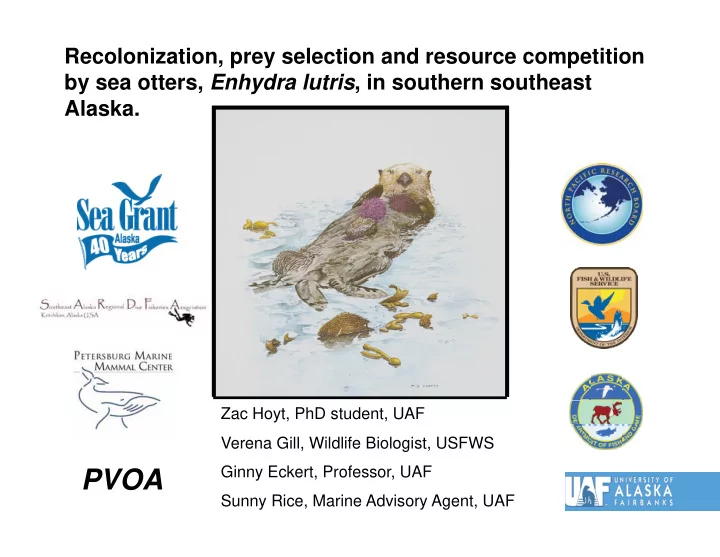

Recolonization, prey selection and resource competition by sea otters, Enhydra lutris , in southern southeast Alaska. Zac Hoyt, PhD student, UAF Verena Gill, Wildlife Biologist, USFWS Ginny Eckert, Professor, UAF PVOA Sunny Rice, Marine Advisory Agent, UAF
Outline 1) � Background – Sea otter biology A) � Historic and current distribution of sea otter in the N Pacific, AK, SE AK, and finally SSE AK. B) � Current distribution and growth of SSE AK otter pop. C) � Resource competition in SE AK
Outline 1) � Background – Sea otter biology A) � Historic and current distribution of sea otter in the N Pacific, AK, SE AK, and finally SSE AK. B) � Current distribution and growth of SSE AK otter pop. C) � Resource competition in SE AK 2) � Foraging A) � Calculate proportion of sea otter diet of commercially important macro invertebrates in SSE AK.
Outline 1) � Background – Sea otter biology A) � Historic and current distribution of sea otter in the N Pacific, AK, SE AK, and finally SSE AK. B) � Current distribution and growth of SSE AK otter pop. C) � Resource competition in SE AK 2) � Foraging A) � Calculate proportion of sea otter diet of commercially important macro invertebrates in SSE AK. B) � Differences in sea otter diet on a spatial scale relating to current sea otter distribution.
The only marine mammals without blubber Sea otters have a high metabolism
Sea otter predators Orcas Sharks Eagles
Only 1 pup/year. Rare twinning.
Population of sea otters ranged from 200,000 – 300,000 pre fur trade
1000 -2000 sea otters in � 1911
Present population 85,000 individuals Current estimate 82,350-95,000 sea otters
Alaska (73,000+) in 3 stocks USFWS 2009
Translocation Sites � � Cape Spencer � � Yakobi Island � � Khaz Bay � � Biorka Island � � Maurelle Islands � � Barrier Islands 51 55
1960’s Release Maurelle Islands 51 otters Barrier Islands 55 otters 2003 Population � � Southern portion (2003) estimated at 5,845 otters � � SE = 821 � � SE AK Esslinger and Bodkin 2009
Survey completed July / Aug. for SSE AK Aerial Survey method Systematic transects, stratified design, with a calculated site ability factor
Results 2010 Growth rate = 13% annually Abundance estimate = In review
2010 13% annual increase since 2003 5,845 otters in 2003
Sea otter harvest levels in SE AK 1989-2010 *
Resource Conflicts
Fisheries affected in southern SE AK - value $16 million dollar (2008 -09) Red Sea Urchin , Strongylocentrotus Dungeness Crab, Metacarcinus franciscanus magister (formerly Cancer magister) California Sea Cucumber, Geoduck Clam, Panopea abrupta Parastichopus californicus
Fisheries Interactions Sea otter abundance YEAR
Foraging data collection
The sea otter diet is extremely diverse Specialists and generalists. High metabolic rate so can eat up to 23% of body weight
Forage in shallow water (0-100 m)
50 mm 1.5 paw Telmessus cheiragonus Coded = TEC – 2b Foraging
2010 Field Work
Results Otter foraging success 116 bouts recorded 1500 dives recorded 1332 successful
Diet composition by taxonomic group
Other commercially important species Pandalus spp. - 2 % Tanner Crab, Chionoecetes bairdi - < 1% Red king crab , Paralithodes camtschaticus Pinto Abalone , Haliotis kamtschatkana
Commercial Component of Sea Otter Diet Proportion of observed diet 108 bouts, 1332 dives
Spatial differences in diet 1) � Colonization history 2) � H o : Commercially important component of diet does not differ by otter colonization history
z= -3.114, p=0.0018 Proportion of observed diet Otters present before 2003 Otters present since 2003 z= 5.121, p<0.0002 z= -1.85, p=0.643
Proportion of observed diet Observed proportion of diet z= 5.121, z= 5.87, No statistical power p<0.0002 p<0.0002
Conclusion • � Results confirm what we have been hearing anecdotally from the commercial fleet. • � Otters are having a significantly greater effect on commercial macro invertebrates on the frontal boundaries of their current distribution especially relating to California Sea Cucumbers and Dungeness Crab. • � More foraging data is needed from the region to address conflict of the other commercially important species.
What’s next • � Continue forage sampling in 2011 • � Caloric/ biomass scale • � Fisheries assessment analysis, depletion rates, spatial scale and economic impacts • � NPRB project Goal: Examine interactions between sea otter population & prey, small- scale distribution, movement, & prey selection on the recolonizing front of the SSE AK population
Special Thanks Icicle Seafood's Kake Tribal USFS - Petersburg Ranger District Bonnie Greenwood Tory Wilson Marlene Wagner Crew of the F/V’s: Kuprenof Kamalar Westerly PERMITS : MMPA permit #041309 Deco Bay IACUC 164017-1
Recommend
More recommend